
Cego is a card game for three or four players played with eponymous German Tarot cards. The game was probably derived from the three-player Badenese game of Dreierles after soldiers returned from the Iberian Peninsula during the Napoleonic Wars and, based on a Spanish game they had encountered, introduced Cego's distinctive feature: a concealed hand, or blind. Cego has experienced a revival in recent years, being seen as part of the culture of the Black Forest and surrounding region. It has been called the national game of Baden and described as a "family classic".
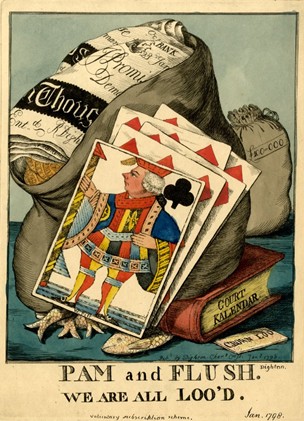
Lanterloo or Loo is a 17th-century trick taking game of the trump family of which many varieties are recorded. It belongs to a line of card games whose members include Nap, Euchre, Rams, Hombre, and Maw. It is considered a modification of the game of "All Fours", another English game possibly of Dutch origin, in which the players replenish their hands after each round by drawing each fresh new cards from the pack.

Rams is a European trick-taking card game related to Nap and Loo, and may be played by any number of persons not exceeding nine, although five or seven make a good game. In Belgium and France, the game of Rams is also spelt Rammes or Rems, in Germany, Rams, Rammes, Ramsch, Ramschen, Ramscheln or Ramsen, in Austria, Ramsen and Ramschen, and, in America, Rounce. The basic idea is fairly constant, but scoring systems vary. It was a widespread European gambling and drinking game that is still popular today. During the 19th century, it was introduced as Rounce in America and played with a 52-card deck without any difference between simples and doubles and with no General Rounce announcement. In the modern German variety of the game, Ramscheln, the 7♦ is the second best trump ranking next below the ace.

Tippen, also known as Dreiblatt, Dreikart, Drei Karten, Dreekort, Kleinpréférence or Labet, is an historical German 3-card, plain-trick game which was popular as a gambling game for three or more players. The Danish version of the game was known as Trekort and more elaborate Swedish variants include Knack and Köpknack. It appears to be related to the English game of 3-Card Loo. It was banned as a gambling game in some places.
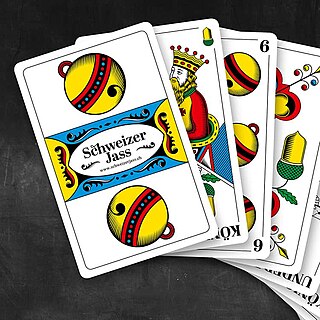
Chratze is a trick taking card game, mainly played in the German-speaking part of Switzerland as well as in Bavaria. It is one of over 70 variants of Jass and played with a pack of 36 cards, either a Swiss-German or French one. It appears to be related to the Austrian game, Kratzen.

Officers' Skat (Offiziersskat), is a trick-taking card game for two players which is based on the rules of Skat. It may be played with a German or French pack of 32 cards which, from the outset of the game, are laid out in rows both face down and face up. As in Skat, tricks are taken and card points counted to determine the winner of a round; game points are then awarded to decide the winner of a game. It is also called Two-hand Skat, Sailors' Skat (Seemannsskat), Farmers' Skat (Bauernskat), Robbers' Skat (Räuberskat) or Coachmen's Skat (Kutscherskat)

Gaigel is a card game from the Württemberg region of Germany and is traditionally played with Württemberg suited cards. It is a Swabian variant of Sechsundsechzig and may be played with 2, 3, 4 or 6 players. However, a significant difference from Sechsundsechzig and other related games like Bauernschnapsen is the use of a double card deck. The four-player game is usually called Kreuzgaigel. The game emerged in the early 19th century.

Bavarian Tarock or, often, just Tarock, is a card game that was once popular in Bavaria and also played in parts of Austria as well as Berlin. The name is a clue to its origin in the historical German game of [Gross-]Tarock, a game using traditional Tarot cards. At some point in the mid- to late-18th century, attempts were made to emulate Taroc using a standard 36-card German-suited pack, resulting in the formerly popular, south German game of German Tarok. During the last century, the variant played with a pot (Haferl) and often known as Bavarian Tarock or Haferltarock, evolved into "quite a fine game" that, however, has less in common with its Tarock progenitor. German Tarok also generated the very similar game of Tapp, played in Württemberg, and both are related to Bauerntarock, Dobbm and the American games of Frog and Six-Bid Solo. Bavarian Tarock should not be confused with Königrufen, also known as Austrian Tarock or just Tarock.

Wendish Schafkopf, Wendisch or Wendsch is a card game for four players that uses a Schafkopf pack of German-suited cards or a Skat pack of French playing cards.

Brandeln is an historical card game for four players in which three play against a soloist. It is one of the earliest games to use the terms Bettel – a contract to lose every trick – and Mord - a contract to win every trick. One of several card games mastered by Mozart, Brandeln is still current in Austria and Germany today. It has been described as having a "civilized, refined and ingenious character" and "one of the most pleasant card games".

Binokel is a card game for two to eight players that originated in Switzerland as Binocle, but spread to the German state of Württemberg, where it is typically played with a Württemberg pattern pack. It is still popular in Württemberg, where it is usually played in groups of three or four as a family game rather than in the pubs. In three-hand games, each player competes for himself, while in four-hand games, known as Cross Binokel (Kreuzbinokel), two teams are formed with partners sitting opposite one another. The game was introduced to America by German immigrants in the first half of the 20th century, where it developed into the similar game of pinochle. Binocle was still played in Switzerland in 1994. In south Germany, the game is sometimes called by its Swabian name, Benoggl.
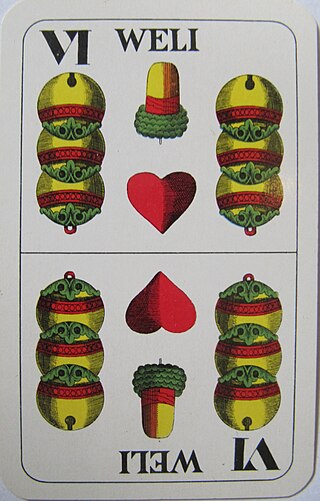
Mauscheln, also Maus or Vierblatt, is a gambling card game that resembles Tippen, which is commonly played in Germany and the countries of the old Austro-Hungarian Empire.
Bester Bube or Fünfkart is an historical German card game for 3–6 players played with a Piquet pack. It is one of the Rams group of card games characterised by allowing players to drop out of the current game if they think they will be unable to win any tricks or a minimum number of tricks. It may be an ancestor of Five-Card Loo.

Ramscheln, also called Ramsch, is a German card game for three to five players, which is usually played for small stakes. It is a variant of Mönch and a member of the Rams group of card games characterised by allowing players to drop out of the current game if they think they will be unable to win any tricks or a minimum number of tricks. It should not be confused with Ramsch, an unofficial contract in Skat, played when everyone passes, in which the aim is not to score the most card points.

Mouche, also known as Lanterlu, is an old, French, trick-taking card game for two to six players which has elements, such as bluffing, reminiscent of the much later game of poker. It is a member of the Rams family of games and, although it is a gambling game, often played for small stakes, it is also suitable as a party game or as a family game with children from the age of 12 upwards. It is named after the mouche, a term that variously refers to its winning hand, the basic stake and the penalty for failing to take any tricks. Although also called Bête, it should not be confused with the older game of that name from which it came and which, in turn, was a derivative of Triomphe.
Spitzeln is an historical German card game for three players and a variant of German Solo.
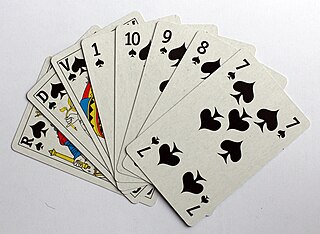
Bête, la Bête, Beste or la Beste, originally known as Homme or l'Homme, was an old, French, trick-taking card game, usually for three to five players. It was a derivative of Triomphe created by introducing the concept of bidding. Its earlier name gives away its descent from the 16th-century Spanish game of Ombre. It is the "earliest recorded multi-player version of Triomphe".

Norseman's Knock or Norrlandsknack is a classic Swedish card game for 3 to 5 players, known since the mid-1800s. It is traditionally played for money. The game is about winning as many tricks as possible and above all not being completely left without a trick.

Köpknack is an old Swedish card game which is a development of Knack and, like the latter, is mainly played for stakes. The game is also known as Trekort which, however, usually refers to a simpler version of Danish origin that may have been its progenitor.
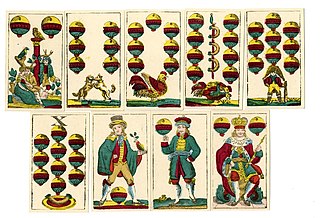
Kauflabet or Kauf-Labet is an historical German trick-taking card game for three to five players that was popular within women's circles.


















